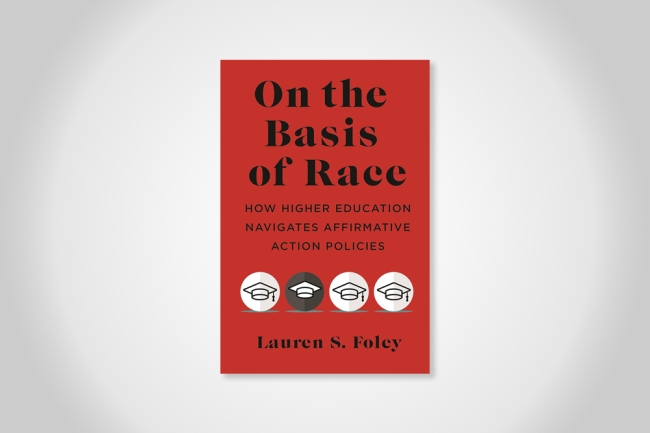You have /5 articles left.
Sign up for a free account or log in.

Lauren Foley’s On the Basis of Race was published Sept. 26.
NYU Press
Lauren Foley, an assistant professor of political science at Western Michigan University, admits that the timing of her book about how colleges and universities respond to bans on affirmative action turned out to be “a little nuts.”
She spent more than a decade researching how colleges and universities persisted in valuing racial diversity following state bans on affirmative action in the 1990s and 2000s. Now, in a prescient new book, On the Basis of Race: How Higher Education Navigates Affirmative Action Policies (NYU Press), Foley outlines how the University of Texas, the University of California system and the University of Michigan responded to bans and court decisions in their respective states.
When she started her dissertation on the subject in 2012, Foley never imagined there would be a national ban on affirmative action. But as she began turning it into a book years later, “the writing was on the wall” that the high court would strike down race-conscious admissions. The only question for her was how sweeping the ban would be.
Though she didn’t initially intend it that way, the book offers a blueprint for institutions in the wake of the Supreme Court’s June decision striking down the use of race-conscious admissions.
“On the Basis of Race picks up where Justice [Sonia] Sotomayor’s dissent in Students for Fair Admissions leaves off,” she wrote in an author’s note penned shortly after the decision. “Justice Sotomayor writes that ‘the pursuit of racial diversity will go on’ through the use of ‘all available tools.’ Universities will comply with the holding, while resisting the decision by developing creative means to pursue racial diversity. This book explains how.”
The book, a series of case studies, explores how colleges have used different strategies, from automatic admissions to holistic evaluations, to resist the legal mandates based on race—a strategy she refers to as “resistant compliance.”
“Resistance, as this book demonstrates, sometimes takes the unexpected form of compliance. Institutions craft racial policies with an eye toward meeting the terms of a legal mandate while also working persistently and creatively to maintain their own understanding of and commitment to advancing or resisting racial equality,” she wrote in the book’s conclusion. “If we see resistance to law only as openly defiant refusal, then we miss the many ways the recipients of law diminish or expand its impact.”
Foley spoke with Inside Higher Ed via Zoom about her book and what colleges and universities can learn from the case studies presented. Excerpts of the conversation follow, edited for length and clarity.
Q: Your book is really about how organizations respond to affirmative action bans and commit to racial diversity. The three universities featured seemed to adopt an almost defiant stance. Some campus presidents even led rallies, which we aren’t seeing now. What do you make of how universities responded so far to the Supreme Court’s decision and how this moment is playing out compared to the situations in your book?
A: You don’t get the big campus rallies because people saw it coming, but also now it affects everybody. The big reason these universities had to come up with something creative is to maintain their competitive advantage. [After the Michigan ban] there were students getting into Northwestern University that weren’t getting into the University of Michigan, and those schools compete pretty directly against each other. Well, now that there’s a national ban, everybody’s been restored to the same footing. Certainly, there’s the urgency, but it’s a different kind of urgency. It’s not a, “Uh-oh, we’re on the back foot now compared to our competitors.”
I think it’s really important to note this is just the beginning. If the Supreme Court wanted to write an opinion that would keep this issue out of the courts, this is not the opinion that they wrote. The policies and responses are going to be challenged, like the kind of policies I wrote about my book. But also how far does the opinion stretch? That’s going to be challenged, too.
Q: We’ve already seen some universities adopt a version of Texas’s plan to automatically admit students who graduate in the top 10 percent of their high schools.
A: And that’s survived and worked well for Texas … The more elite you are, the more difficult this is going to be.
Q: In the book, you talk a lot about the concept of resistant compliance. In one chapter, you point to how Oklahoma City Public Schools used lawsuits and other tactics to resist court orders to integrate its schools to delay desegregation for a decade or more while professing that it was complying. What would this look like for higher education?
A: Theoretically in political science, there isn’t understanding that there are a lot of different ways to comply. Just because you don’t want to do something, that doesn’t mean that you’re out there like George Wallace on the schoolhouse steps saying, “Segregation now, segregation forever.” You can actually lead with compliance.
Dedication to the mission is resistance. In my interviews, nobody was saying, “Gosh, guys, this student diversity thing is really slowing us down. We are spending a lot of time and energy on this. Now we’re going to be even more handicapped. Can we just give this up and pivot to something else? Let’s focus on STEM.” Nobody’s saying that.
There’s a defiant commitment to racial diversity and also a total commitment to being in compliance. So how do we understand that theoretically in political science; what kind of response is that? Because it says something about the limits of a law’s effectiveness. These organizations are mediating the effectiveness of these laws.
I wanted to get that piece theoretically into political science. As reformers, everybody has something they’re passionate about. These conservatives are passionate about ending affirmative action, but liberals are passionate about expanding abortion rights. As reformers, we look to courts of law and we think, “Oh, if we could win our ideal legal language …” The truth is who interprets it and the target of that law matters a lot, and what will happen? And we need to think more about that as reformers. We can’t just depend on courts to win us the goals that we want, whatever those goals are—liberal or conservative. You have to look at implementation, too.
Q: What do you hope higher education leaders take away from your book?
A: I think the importance of this being a collaborative group effort—the sharing of strategies and sharing of information and that this isn’t a case of first impression. There are instances out there. There are strategies out there; there are techniques out there. It’s going to be case by case, but there’s a lot that you can borrow from and innovate on.
I think it’s an interesting and exciting time in higher ed to see more innovation, and I think the university administrators [in the book] were really creative. The biggest difference between the Oklahoma City [Public Schools] chapter and the university chapters is the creativity. Oklahoma City just relied a lot on their lawyers to come up with a lot of delay tactics in the courts. So much of this was the creativity of education leadership. Even in Texas, the [plan] that had to be formalized as a policy decision by the Texas state Legislature still came out of an academic brain trust of professors who got together with legislators and gave them the ideas, and then legislators formed it into a piece of public policy. There’s a lot of creativity. This is a story of creativity and innovation, and I hope that people build on that and use what has come before and build on it.
Q: In some of the case studies, you show that there was some bipartisanship involved in reaching solutions. How do you think that will play out now?
A: There are a number of race conservatives who are supportive of race-neutral means and actually want universities to move over to looking more at socioeconomic status and privilege that in the admissions process. There are also race conservatives who don’t support legacy admissions. There are some areas of overlap here. I don’t want to get too far ahead of myself. I feel like these techniques will be challenged still now … So I don’t know if the level of bipartisanship is the same as it was 20 years ago.
Q: Anything else you want to mention?
A: This is just the beginning of these cases on affirmative action.



